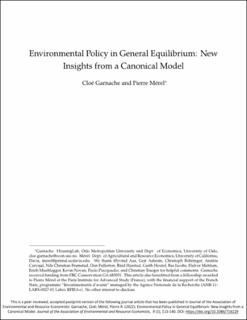| dc.contributor.author | Garnache, Cloé | |
| dc.contributor.author | Mérel, Pierre R. | |
| dc.date.accessioned | 2023-02-21T15:30:49Z | |
| dc.date.available | 2023-02-21T15:30:49Z | |
| dc.date.created | 2021-09-20T11:55:42Z | |
| dc.date.issued | 2022-11-05 | |
| dc.identifier.citation | Journal of the Association of Environmental and Resource Economists. 2022, 9 (1), 113-140. | en_US |
| dc.identifier.issn | 2333-5955 | |
| dc.identifier.issn | 2333-5963 | |
| dc.identifier.uri | https://hdl.handle.net/11250/3052869 | |
| dc.description.abstract | This paper derives the incidence of a pollution tax in a stylized general equilibrium framework, building on previous work by Fullerton and Heutel. Using the CPI as numeraire, we show that tax incidence is a simpler problem than previously thought and that general insights can be derived without the need to restrict the parameter space. In addition, the counterintuitive possibility that an increase in the tax could increase the pollution level vanishes. The choice of the CPI as numeraire is further justified by the fact that environmental taxes, notably carbon taxes, are typically indexed on inflation. | en_US |
| dc.language.iso | eng | en_US |
| dc.publisher | The University of Chicago Press | en_US |
| dc.relation.ispartofseries | Journal of the Association of Environmental and Resource Economists;Volume 9, Number 1 | |
| dc.title | Environmental Policy in General Equilibrium: New Insights from a Canonical Model | en_US |
| dc.type | Peer reviewed | en_US |
| dc.type | Journal article | en_US |
| dc.description.version | acceptedVersion | en_US |
| cristin.ispublished | true | |
| cristin.fulltext | postprint | |
| cristin.qualitycode | 2 | |
| dc.identifier.doi | https://doi.org/10.1086/716229 | |
| dc.identifier.cristin | 1935936 | |
| dc.source.journal | Journal of the Association of Environmental and Resource Economists | en_US |
| dc.source.volume | 9 | en_US |
| dc.source.issue | 1 | en_US |
| dc.source.pagenumber | 31 | en_US |
| dc.relation.project | EU/ERC Conservation GA 683031 | en_US |
